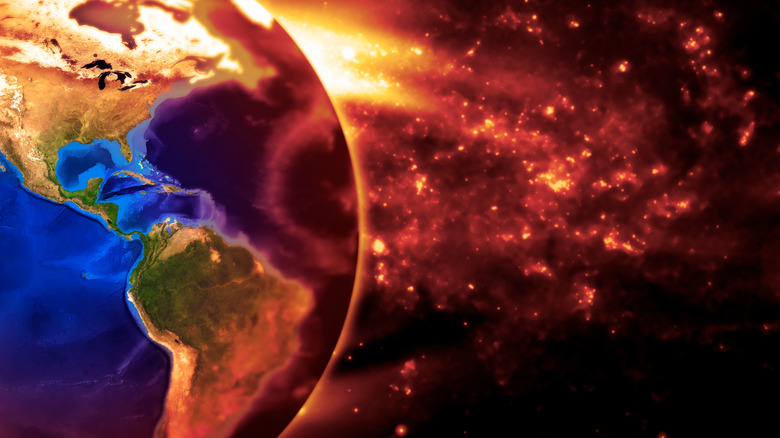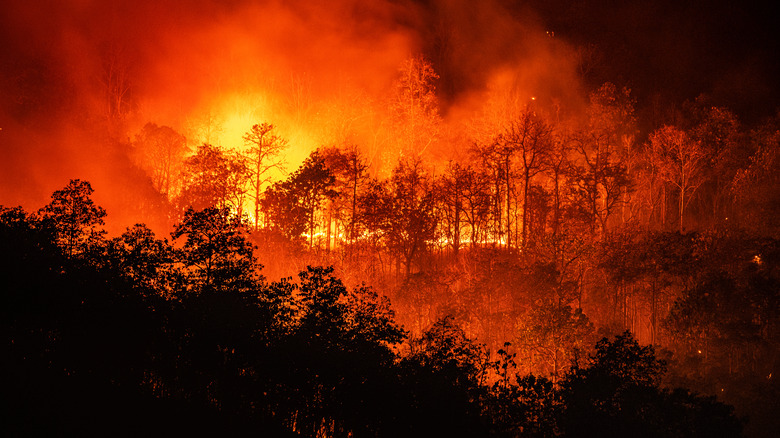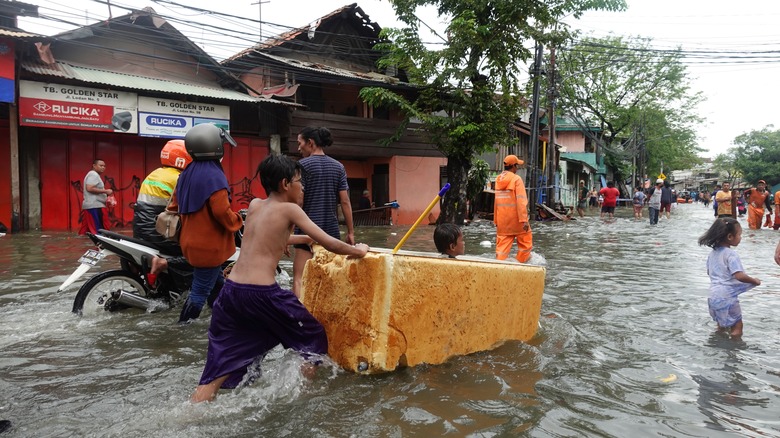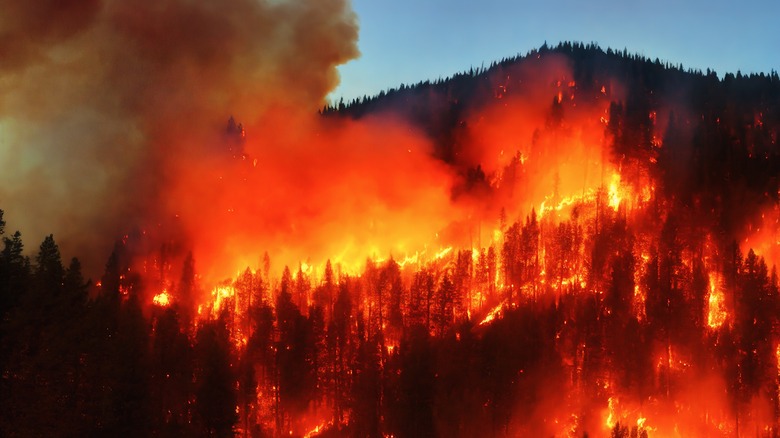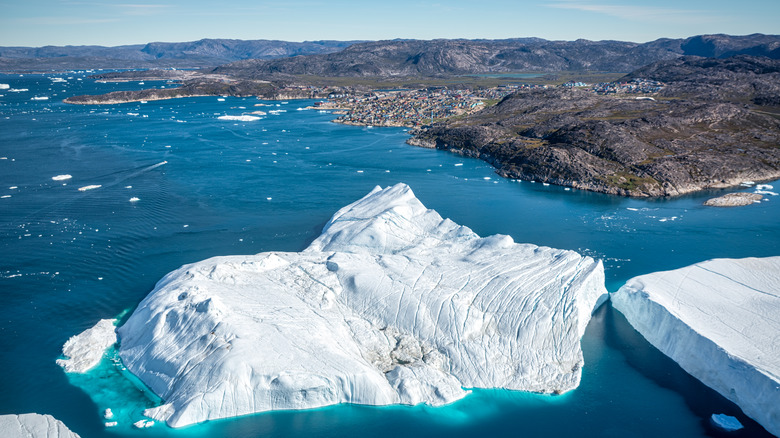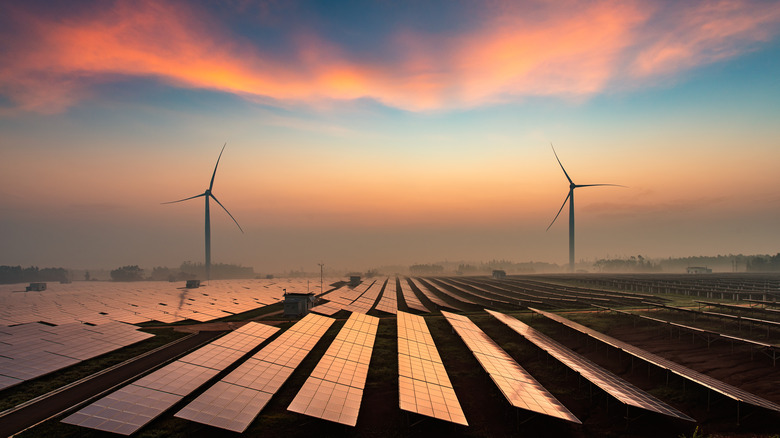How Hot Can Earth Get And What Would Happen Next?
If it seems like the weather has been getting really wonky lately — and generally, a lot warmer — that's because it has been, thanks to the phenomenon of global climate change. In a nutshell, the mean temperature of the Earth's surface is steadily rising, due in large part to the steadfast refusal of humankind to stop filling the atmosphere with heat-trapping greenhouse emissions, despite virtually every climate scientist on the planet imploring us to do so for decades. For the record, the science on this issue is absolutely settled; human activity is causing the phenomenon, and while there are large swaths of people who refuse to believe it, this unfortunately does not make it any less true.
For those of us who are actively concerned about the issue (which should be every single one of us), a few key questions may rise to the forefront of any discussion: How bad could rising temperatures get, and how quickly? What will the effects of global climate change be, and how will they impact us? And most importantly, what can be done about the problem? The answers are more straightforward than one might think, but be warned: many of them aren't pretty, and they spell out the undeniable truth that global climate change is an issue that must be addressed by the whole of humanity, head-on — and right now.
Just how hot could Earth get?
According to an analysis by the Intergovernmental Panel on Climate Change, a body of the United Nations, the mean temperature of the Earth's surface has risen by about one degree Celsius since the industrial revolution. The analysis points out that this is a global mean — in some parts of the world, the average temperatures have risen even higher, and the effects have already begun to be felt. The 2015 Paris Climate Agreement, an accord between member nations to limit greenhouse emissions, aims to keep this mean temperature increase firmly under two degrees, with a stated goal of keeping it under 1.5 — the point beyond which some changes may become irreversible.
It's worth asking the question: If we were to continue pumping greenhouse emissions willy-nilly into the atmosphere, with no mitigating measures taken to curb the resulting climate change, just how hot could the Earth get? Unfortunately, there really is no upper limit — but there is a point at which the Earth would become completely uninhabitable, which happens to be about 12 degrees above pre-industrial levels. This is not a hypothetical scenario: Earth has experienced five mass extinctions in the past, the worst being 252 million years ago, when a combination of environmental factors, including the release of excess carbon and methane into the atmosphere, caused the global mean temperature to rise beyond 5 degrees — eradicating over 90 percent of all species on Earth. We are, of course, dumping emissions into the atmosphere at a much greater clip now — and that sneaky combination of environmental factors could combine with industrial activity to propel global mean temperatures to untold heights.
El Niño could make the next couple years even worse
Natural weather phenomena can result in a significant, if temporary, bump in global temperatures. There is one in particular we should be concerned with: El Niño, the periodic warming of the seas' surface temperatures, which can have drastic and unpredictable effects on both localized weather and overall global climate. The latest edition was predicted to arrive in force late in 2023, and during the previous event — which occurred from 2014 to 2016 — Earth recorded its hottest year ever to close out that period. Even with El Niño just beginning to assert itself, mid-2023 was already giving 2016 a run for its money, as July 3, 2023, was officially the hottest day ever recorded in human history, and scientists warned that it's just the beginning.
"It's not a record to celebrate," said Friederike Otto, a lecturer at the Grantham Institute for Climate Change and the Environment in the U.K., "and it won't be a record for long, with northern hemisphere summer still mostly ahead and El Niño developing" (via CNN). When that phenomenon gets into full swing, it will almost certainly contribute to increased warming — and wreak havoc with weather systems worldwide, bringing torrential rains in some areas and blistering droughts in others. This will obviously make the next couple of years a challenge with respect to reining in rising global mean temperatures — but if that challenge isn't met, the next few years beyond that will likely bring the milestone that climate scientists are dreading.
The next five years might bring a grim milestone
Some studies, including by the Intergovernmental Panel on Climate Change, have warned that 1.5 degrees Celsius of warming over pre-industrial levels could become a reality as soon as 2040 — but unfortunately, such estimates are beginning to look overly optimistic. According to a 2023 study by the World Meteorological Organization, the chances that we will hit that mark for at least one year between 2023 and 2027 currently stands at about 66 percent — and the chances that we'll hit other, similarly grim milestones, like a new hottest year on record and a new highest five-year mean, are considerably higher. (That is to say, almost certain.)
If that 1.5-degree benchmark becomes a new norm, the changes we'll see will be significant, affecting huge swaths of the global population. Rising sea temperatures could cause the world's coral reefs, which are already struggling, to die off completely. A warmer atmosphere will become a more humid atmosphere, which will contribute to extreme weather events — like extra-powerful hurricanes in the vein of Hurricane Ida, which killed dozens on the East Coast in 2021— becoming even more commonplace. Heat waves in some areas will become longer and more extreme, and rising sea levels will worsen the plight of the many cities worldwide that are already slowly sinking. At this point, the consequences of inaction will be difficult to ignore — but if we persist in doing so, we may soon reach a point of no return.
The next decade could bring catastrophic consequences
In November 2022, the U.N. Framework Convention on Climate Change published a report which analyzed collected data from all the member nations of the Paris Agreement, to assess the overall efficacy of said nations' approach to cutting greenhouse emissions. In short, the report concluded that the measures being taken were simply not enough to drastically slow or stop the rise in global mean temperature — an assessment that makes the scenario put forth by a separate study, one assisted by artificial intelligence, all too plausible.
That study, published by the Proceedings of the National Academy of Sciences, suggests that we are indeed on track to breach the 1.5-degree Celsius threshold much sooner than previously estimated — and worse still, that the 2-degree Celsius mark could be reached within a decade, even if greenhouse emissions are reduced considerably beyond their current levels. If this occurs, we can expect to see even more extreme temperatures, particularly in tropical areas, and a raft of other effects, including droughts that could threaten the clean water supply in some regions; even more powerful extreme weather, plus heavier overall precipitation resulting in more populated areas dealing with flooding; more instances of wildfires, and the threat of many plant and animal species going extinct. What's more, the previously mentioned IPCC report suggests that at this point, many of the changes to the Earth's climate will become permanent — and pushing global mean temperatures back down to 1.5 degrees above pre-industrial levels will no longer be attainable.
The end of this century could see a radically changed world
If warming continues beyond a global mean of 2 degrees Celsius over pre-industrial levels, its effects will only become more pronounced — and while this isn't likely to happen within our lifetimes, our children and their children would be inheriting a radically changed, and very hostile world. This was spelled out in stark detail in the Intergovernmental Panel on Climate Change's summary of its report, which noted a huge gap between what Paris Agreement member nations are doing, and what actually needs to be done.
According to the summary, an increase in global mean temperature of 2.5 degrees could occur by 2100 — a circumstance that would bring with it the deaths of untold thousands due to frequent, killer heat waves, the virtually worldwide threat of catastrophic flooding, more outbreaks of deadly diseases, a huge increase in areas affected by food and water insecurity, and the partial or complete collapse of entire ecosystems, among other potential consequences.
Speaking to the press at the COP26 climate summit in Glasgow, Scotland, in 2021, U.N. Environment Program official Inger Andersen placed the blame for the lack of progress squarely on the member nations of the Paris Agreement. "When we look at what has come in, the additional pledges, frankly it's the elephant giving birth to a mouse," Andersen said. "We are not doing enough. We are not where we need to be. And we need to step up with much more action, much more urgency" (via The Seattle Times).
Further warming will see some populations sweltering while others starve
Minute changes in overall global temperatures can lead to drastic worldwide changes, and if you think the world sounds scary and hostile at 2.5 degrees Celsius of warming, it will look nothing short of terrifying at 3 degrees. Speaking with Science Norway after the COP26 summit, University of Bergen researcher Helge Drange expressed the disconcerting opinion that based on our current course, this is not just possible, but likely. "I already consider 1.5 and 2 degrees to be almost unattainable," he said. "Now the question is how close to three we will get."
At 3 degrees Celsius of warming, we'll be looking at the kind of once-in-a-generation heat waves, capable of killing thousands of people, occurring 30 times more frequently. Our infrastructure for dealing with extreme heat and water management, built to contend with a much cooler climate, will simply become useless — turning up the air conditioning and building more underground water pumping facilities, like the one currently keeping Tokyo from being inundated with floodwaters, just won't cut it. Agriculture will suffer mightily and livestock will die off, leading to sweeping epidemics of malnutrition and starvation; wildfires will run rampant, and vast swaths of coastal areas will vanish beneath the rising ocean, displacing millions of people — and melting permafrost will dump even more greenhouse gases into the atmosphere, accelerating warming yet further.
The mass extinctions begin
As the rise of global temperatures continues, vast populations of displaced people are likely to find themselves without many options for relocation. In 2019, the U.N. Environment Programme published a short video imploring the nations of the world to come together to reduce greenhouse gas emissions — noting that if they fail to do so, global mean temperatures could go shooting past 3 degrees Celsius above pre-industrial levels at the turn of the next century. If this happens, significant portions of the Earth could simply become uninhabitable — and mass extinctions of huge numbers of plant and animal species will become not just a threat, but a reality.
According to an analysis by the Columbia Climate School, the loss of these species could pose just as profound a threat to humanity as heat waves and catastrophic flooding. As species die off, ecosystems can become unbalanced in unpredictable ways — leading to the proliferation of invasive species and eliminating natural buffers to infectious diseases, for example.
In addition, a loss of species variety would cause serious disruption to an already unstable food chain, accelerating the malnutrition and starvation already wrought by failing crops and diminishing herds of livestock. As global mean temperatures continue to increase, the interconnectedness of our planet's systems will become all too apparent — as they all begin to fail, the planet may cease to be hospitable to the current human population.
Tipping points could come unexpectedly
It should be pointed out that, even if greenhouse emissions remain consistent and constant, it does not mean that the rise of global mean temperatures will share that consistency. As pointed out in an analysis by the University Corporation for Atmospheric Research, rising temperatures could trigger a number of devastating "trigger points" in an unpredictable fashion, occurrences which could then cause the rate of warming to accelerate much more quickly.
These trigger points are varied, but all are pretty terrifying. For example, the sudden release of large quantities of methane gas due to the melting of Arctic permafrost, greatly amplifying the greenhouse effect, or a change in the circulation of waters in the world's oceans, which would disrupt the way heat is distributed in the atmosphere. Then there's the threat of a swift collapse of large portions of ice sheets in Antarctica and Greenland, which would lead to a greater-than-predicted rise in sea levels over a short time, or carbon dioxide saturation of the world's seawater, which would eliminate a major natural filter of that greenhouse gas.
UCAR noted that none of these occurrences are extremely likely to take place within the next few decades — but "unlikely" doesn't mean "impossible," and "probably not any time soon" doesn't mean "never."
Hell on Earth, literally
If global mean temperatures reach 4 degrees Celsius above pre-industrial levels, Earth will start to look like a terrifying dystopian hellscape, one that even Hollywood would struggle to envision. In 2014, the World Bank published a report outlining the consequences of allowing the Earth to heat up to this degree, and they are horrific indeed. Virtually all of the world's coastal cities will be lost to the seas, food and water scarcity will reign supreme, and new, awful diseases will wipe out giant chunks of the population. Those regions of the world not baking in near-endless heat waves will be under constant threat from mega-powered storms and relentless flooding, and the oceans will become acidic, leading to the loss of massive populations of marine life. In short: Hell on Earth.
At this point, as one might imagine, the entire world will be swiftly approaching the point of being completely uninhabitable, and it's unlikely that we as a species will have any means to adapt enough to ensure our survival. Soon enough, we, too, will be at risk of joining the hundreds of species to vanish forever as a result of our stubborn unwillingness to confront the truth before us today — that climate change is, as stated bluntly by the famed naturalist David Attenborough, "the biggest threat to security that modern humans have ever faced."
Solutions exist to avoid disaster
But there's some good news: The technology and know-how to avoid the consequences of climate change, partially or even completely, already exists. In terms of slowing down global temperature increases due to human activity, climate scientists pretty much know exactly what needs to be done — phasing out fossil fuels in favor of renewable energy, undertaking new construction and industrial projects with a focus on energy efficiency, transitioning from gasoline-powered to electric vehicles, and reducing clear-cutting of forests (which serve as another huge natural filter for carbon dioxide). The question, of course, is whether the world's governments will take the necessary actions — and, more pointedly, whether the energy corporations that benefit from the status quo can be compelled to change course.
It's also worth noting that even if the contribution of greenhouse gases from industrial activity stopped immediately, global increases in mean temperature would continue to occur naturally (at least until the next glacial period, but that won't be for 50,000 years or longer). This means that, in addition to taking action to reduce our impact on climate change, it would also be prudent to employ measures to adapt to naturally occurring warming — measures such as improved anti-flooding and drainage systems, agricultural adjustments to changes in the duration of growing seasons, and greater allocation of resources for forest management, to name a few.
Combating climate change, in short, will require a sustained and multi-faceted effort by the entirety of humanity — an effort upon which our very future on this planet depends.
